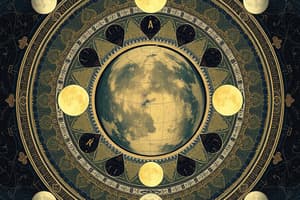Podcast
Questions and Answers
If the Earth, Moon, and Sun were aligned in a straight line, with the Moon in the middle, which lunar phase would be observed?
If the Earth, Moon, and Sun were aligned in a straight line, with the Moon in the middle, which lunar phase would be observed?
- Full Moon
- Third Quarter Moon
- New Moon (correct)
- First Quarter Moon
Which of the following statements accurately describes the difference between waxing and waning phases of the Moon?
Which of the following statements accurately describes the difference between waxing and waning phases of the Moon?
- Waxing refers to the moments before a New Moon, and waning refers to the moments before a Full Moon.
- Waxing refers to the decreasing of the Moon's visible surface, while waning refers to its increasing.
- Waxing refers to the period when the Moon is only visible during the day, and waning when it is only visible at night.
- Waxing refers to the increasing of the Moon's visible surface, while waning refers to its decreasing. (correct)
During a lunar cycle, after the First Quarter Moon, which phase comes next?
During a lunar cycle, after the First Quarter Moon, which phase comes next?
- Waxing Gibbous (correct)
- Waning Gibbous
- New Moon
- Full Moon
Imagine you observe a crescent moon in the sky shortly after sunset. Over the next few evenings, you notice the crescent is growing larger. Which phase are you observing?
Imagine you observe a crescent moon in the sky shortly after sunset. Over the next few evenings, you notice the crescent is growing larger. Which phase are you observing?
A student claims that the phases of the moon are caused by the Earth's shadow falling on the moon. Is their claim correct?
A student claims that the phases of the moon are caused by the Earth's shadow falling on the moon. Is their claim correct?
Flashcards
Moon Phases
Moon Phases
The different appearances of the Moon as seen from Earth, determined by the relative positions of the Moon, Earth, and Sun.
Full Moon
Full Moon
The phase when the Moon appears fully illuminated from Earth.
Earth, Moon, and Sun Relationship
Earth, Moon, and Sun Relationship
The Earth, Moon, and Sun's movements relative to one another and their resulting effects.
Waxing
Waxing
Signup and view all the flashcards
Waning
Waning
Signup and view all the flashcards
Study Notes
- The Earth, Moon, and Sun's relative positions and motions affect various phenomena.
- The Solar System includes the Sun, Earth, other planets, natural satellites, comets, asteroids, and meteoroids, each having distinct physical characteristics.
Oreo Cookie Moon Phases
- The goal is to identify the cyclic phases of the Moon.
- Another learning objective is to explain the positions of the Earth, Moon, and Sun during each phase.
- Waxing and waning Moon phases can be distinguished.
Phases of the Moon Demonstration
- A demonstration involves a person representing Earth, holding a sphere to represent the Moon, with a light source simulating the Sun, to visualize lunar phases.
Studying That Suits You
Use AI to generate personalized quizzes and flashcards to suit your learning preferences.




